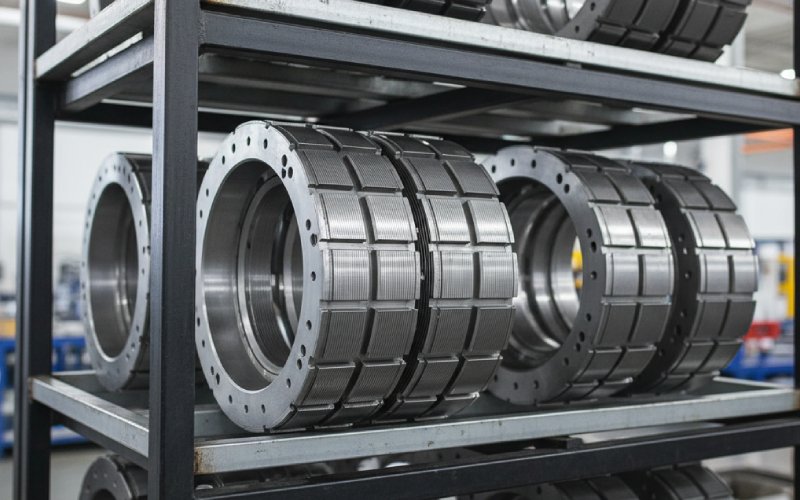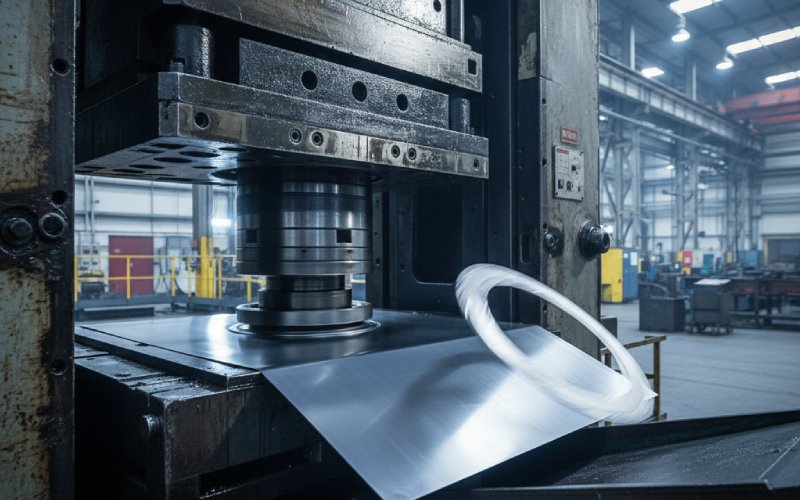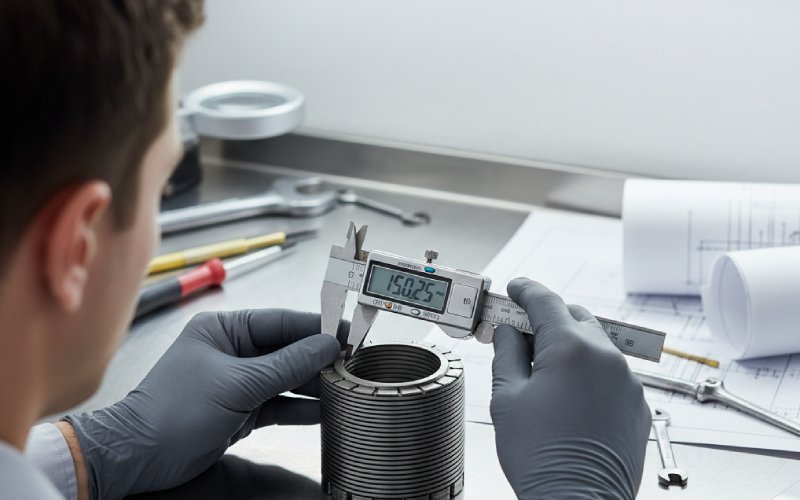Let Sino's Lamination Stacks Empower Your Project!
To speed up your project, you can label Lamination Stacks with details such as tolerance, material, surface finish, whether or not oxidized insulation is required, quantity, and more.

The stator core is the very heart of every electric motor. It is the solid part that stays still and makes movement happen. Learning how we design and manufacture a stator core is very important for making motors that are better, stronger, and use less energy. This article will show you the entire manufacturing process. You will find out what a stator core is, why it is so important, and the exact steps used to build one. This information is great for anyone who works with a motor or just likes to know how things are made.
A stator core is the part of an electric motor that does not move. Think about a motor. It has a part that spins and a part that does not move. The stator core is the main part that stays in one place. This stator core is not one solid piece of metal. It is actually a stack of very thin metal plates. These plates are called a lamination. The stator core makes a path for the magnetic field inside the motor. This magnetic field is the thing that makes the motor work.
The word “stator” comes from “stationary,” which means it does not move. The word “core” means it is the part in the middle. So, the stator core is the non-moving center of the motor’s electrical parts. The quality of the stator core is very important for the motor. A good stator core helps the motor work well. A bad stator core can make a motor weak and waste a lot of power. Every rotating electrical machine needs a good stator core to work correctly. The whole design and manufacture process is all about making the best possible stator core for a certain kind of motor.
The stator is a very important part of any motor. The main job of the stator core is to guide the magnetic field. Copper wires, which are called a winding, are wrapped all around the stator core. When electricity goes through this winding, it makes a strong magnetic field. The stator core makes this field stronger and points it toward the moving part of the motor. If the stator core is not made well, the magnetic field can get out. This makes the motor weaker and wastes energy.
A well-made stator core helps to improve motor efficiency. Efficiency is a word that means how well the motor changes electrical power into movement. A motor with high efficiency saves electricity and also saves money. The stator core also helps to keep the motor cool. The thin laminations that are used to make the stator core help to decrease the heat that is created by changing magnetic fields. If the stator core were just one solid block of steel, it would get very hot much too fast. A motor that stays cool will last longer and work better. So, a good stator core is very important for making a motor that is strong, saves energy, and lasts a long time.
Using a lamination stack is a very clever idea in motor design. Like we said, a stator core is not a single piece. It is made from a stack of thin steel plates. Each one of these plates is a lamination. Each lamination in the stator core has a thin, non-electric layer. This layer separates it from the next one. This design is very important for how well the motor works. It helps to stop something that is called “eddy currents.”
Eddy currents are small circles of electrical current. They can form inside a solid piece of metal. This happens when the metal is in a magnetic field that is always changing. These currents do not help the motor run. They just make heat and waste power. When we use a lamination for the stator, we can stop these currents from getting big. Because each lamination is very thin, large eddy currents cannot form. This helps lower the amount of energy that is wasted and helps keep the stator cool. The thickness of each lamination is very important. For a high-speed motor, the lamination might be just 0.35 mm thick. This small thickness makes a big difference in the motor’s efficiency. How well the whole stator works depends on how good each lamination is.

There is more than one type of stator core. We can sort them into groups by their design. This classification helps us pick the right stator core for a specific job. One way to group a stator core is by the kind of motor it is for. Some motors have the rotor (the part that spins) on the inside. The stator is a hollow ring that goes around it. Other motors have the stator on the inside and the rotor spins around the outside of it. How we design and manufacture the stator core is very different for each type.
Another way to group them is by their shape. Most motors are round, so they use a cylindrical stator core. But some machines, like magnetic levitation trains or machines in a factory, use a linear motor. A linear motor works by moving in a straight line instead of spinning. The stator for a linear motor is a long, flat bar. This linear stator core has its own special way of being made. The way we manufacture a stator core really depends on what it will look like and what it will be used for. This grouping helps engineers pick the best way to make the stator.
The main material used to manufacture a stator core is a special kind of steel. This steel is called electrical steel. It is not the same kind of steel used to build a car or a bridge. Electrical steel is made to have special magnetic abilities. It can be turned into a magnet easily, and it can lose its magnetism easily too. This is very important because the magnetic field inside a motor is always changing. This steel helps the stator core guide the magnetic field and lose very little energy.
Each lamination is cut from a big sheet of this electrical steel, which is also called a steel plate. Before the steel plate is used, it is usually covered with a very thin layer. This layer can be varnish or an oxide. This covering works like an insulator, which means electricity can’t pass through it. When the laminations are put in a stack to make the stator core, this covering stops electricity from moving between them. This is how we decrease the wasteful eddy currents. Picking the right electrical steel and coating is very important for how well the final motor stator will work.
The most common way to make a lamination is by using a process called stamping or punching. A very large machine called a press is used for this. This machine has a very sharp tool, called a die. This die is the exact shape of the lamination. A roll of electrical steel sheet is put into the press. The press then comes down with a lot of force. It uses the die to punch the lamination shape out of the steel sheet. This process is very fast and can make hundreds of laminations every minute.
It is very important for this process to be exact. Every lamination for a stator core must be almost exactly the same. If the sizes are not right, the final stator core will not fit together in the right way. A bad stamp can make rough edges. These rough edges can harm how well the motor stator’s magnetic field works. The method and apparatus for stamping have been improved with many new ideas to make it faster and more exact. The goal is to make a perfect lamination for the stator every time.
After thousands of laminations are stamped, they need to be put together to make the motor core. This step is called stacking, or assembly. The main goal is to put together a stack of laminations that is a certain height. All the laminations in the stack must be lined up perfectly. Even a tiny twist can harm how well the stator core works. To help line them up, small cuts are often made on the outside of each lamination.
There are a few ways to hold the stack together to make the finished laminated stator core.
The way we put together the stator core depends on the motor’s design and how much it costs to make. The finished part looks solid, but each lamination is separated so electricity can’t flow between them. It is now ready for the next step.
Most people think that motors are round things that spin. These motors use a round, or cylindrical, stator core. The manufacturing process for this type of stator is understood by many people. The laminations are stacked up to make a hollow circle. The diameter and the length of this stator core are very important measurements.
But some motors need to create movement in a straight line. These are known as linear motors. A linear motor uses a linear stator. You can imagine taking a round stator, cutting it open, and then unrolling it so it becomes a flat bar. That is what a linear stator core looks like. The manufacturing process is not the same. Instead of stacking round laminations, a linear stator is often built from long, rectangle-shaped laminations. The stator core is a long, straight stack. This kind of stator is used in trains, elevators, and other machines that need exact straight-line movement. The design and manufacture of a linear stator core comes with its own special problems to solve.

The whole trip from a roll of steel to a finished stator core can be broken down into a few main manufacturing steps. Each step has to be done with a lot of care to make sure the motor stator is high quality. The whole manufacturing process for a stator core is very exact.
Here is a simple table that shows the main steps:
| Step Number | Step Name | Description |
|---|---|---|
| 1 | Material Choice | Choosing the right kind of electrical steel with the correct thickness and covering for the motor. |
| 2 | Stamping / Punch | Cutting the lamination shape from the steel sheet using a fast press. This makes the basic lamination. |
| 3 | Deburring | Taking off any small, rough bits from the stamped lamination to make sure the stack is clean. |
| 4 | Stacking | Putting the single laminations on top of each other in an exact stack to the right height. |
| 5 | Joining | Joining the lamination stack together using methods like welding, glueing, or interlocking. |
| 6 | Final Machining | Sometimes, the outside of the stator core is shaped for a perfect fit inside the motor’s outer case. |
| 7 | Quality Control | Checking the finished stator core to see if it has the right size, electrical features, and other qualities. |
This process makes sure that every stator core is good enough for a modern electric motor. The stator core of the present design is made using this careful process.
Engineers are always trying to find ways to improve the stator core manufacturing process. A better process can make better motors and lead to big savings. One thing they focus on is making less waste. When laminations are stamped from a steel plate, there is always some steel left over. New ways to place the stamp patterns can use more of the steel and get rid of less scrap metal. This is better for our world and it also saves money. Improving motor efficiency begins with a better stator core.
Another way to improve is by using new technology. A fast search on Google Patents will show many new ideas for manufacturing a stator core. Some people are working on new ways to stamp or cut a lamination with lasers to get even more exact results. Other people are making new kinds of glue that make the stator core stronger and better at handling heat. Every improvement in the manufacture of the stator core helps to make a motor that has more power, wastes less energy, and is quieter. This is also important when fixing or taking care of dynamo-electric machines. A better stator core can last for a longer time. The benefit of a better process is easy to see: a better motor for everyone.